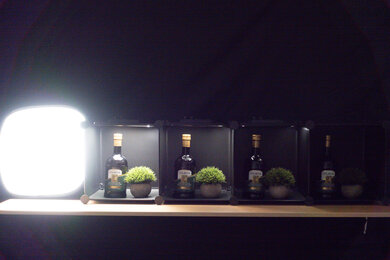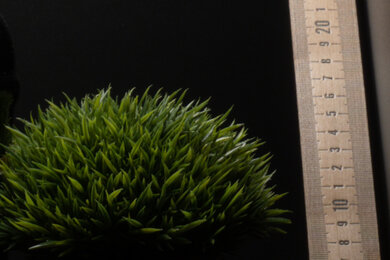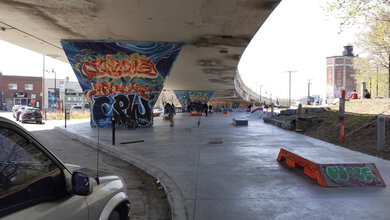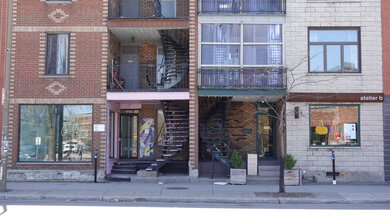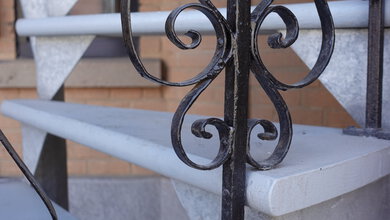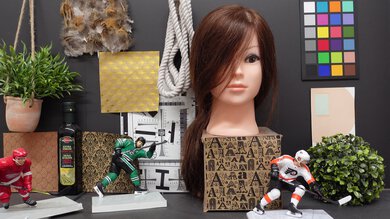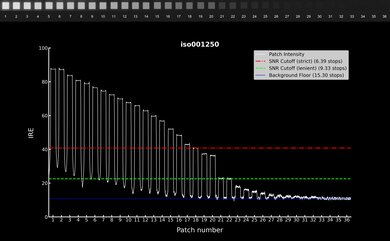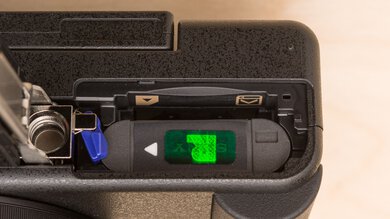The Sony ZV-1 is a compact vlogging camera for those who want to step up from shooting vlogs on their smartphone. It's similar to the premium Sony RX100 VII and borrows its 1-inch sensor from a previous iteration of the RX100 series, but it has a more vlogging-oriented design and features. That means you don't get a pop-up viewfinder or flash, but you do get a fully-articulated screen that's ideal for vlogging. The camera also has a directional microphone with a detachable windscreen to cut down on ambient noise and a hot shoe to attach a flash or aux mic. Its built-in 24-70mm f/1.8-2.8 Zeiss lens also gives you a bit of flexibility with framing.
Our Verdict
The Sony ZV-1 is good for travel photography. It's very portable and easy to take on the go, and its fully articulated screen is great for selfies. Image quality is great for a compact camera. It also has a very reliable autofocus system with excellent tracking capabilities for faster subjects. On the flip side, its battery life is quite limited, so you might need to carry a spare or a portable battery pack while traveling. It also lacks a viewfinder, which can be a problem on sunny days when it's harder to see the screen.
- Compact, lightweight design.
- Sharp, bright, fully articulated screen.
- Built-in ND filter.
- Out-of-camera photos look sharp.
- Poor battery life.
- No viewfinder.
- RAW noise handling is just decent.
The Sony ZV-1 isn't intended for landscape photography, but it's a decent option if you need something compact and lightweight. Images are reasonably sharp and detailed. However, it's less suited to low-light shooting because of its small sensor, and its RAW noise handling and dynamic range aren't the best, making it harder to capture very detailed, high-contrast landscapes. On the upside, the lens' built-in ND filter gives you some added flexibility for long exposure landscapes in bright environments.
- Compact, lightweight design.
- Sharp, bright, fully articulated screen.
- Built-in ND filter.
- Out-of-camera photos look sharp.
- Poor battery life.
- RAW noise handling is just decent.
- Some controls feel a bit sluggish.
The Sony ZV-1 is decent for sports and wildlife photography if you need something compact, though this isn't its main intended use. While it can shoot at a very fast 24 fps in its 'Hi' continuous shooting mode, it can only do so with its electronic shutter, which can cause distortion with very fast-moving subjects like birds. That said, it can still shoot at a respectable 10 fps with its mechanical shutter. Unfortunately, it takes a long time for it to clear its buffer, leading to prolonged interruptions if you fire off several long bursts. The max focal length of its built-in lens isn't very long either, so it isn't suitable for far-away subjects. Some of its controls can also be a little slow to respond to inputs, which can be frustrating when shooting sports or wildlife, where timing is critical. On top of that, there's no viewfinder, which can be an issue when it's too sunny to clearly see the screen.
- Sharp, bright, fully articulated screen.
- Fast continuous shooting speed.
- Out-of-camera photos look sharp.
- Slow buffer clearing speed.
- No viewfinder.
- Limited focal length.
The Sony ZV-1 is great for vlogging. The camera's compact, lightweight design makes it easy to carry around handheld for long periods, and it feels comfortable to shoot with when held in a selfie position. Its fully articulated screen makes it easy to monitor yourself while vlogging. However, its lack of touch capability means you have to turn the camera around to adjust settings when the screen is facing you, which can be a bit of a hassle. The autofocus system can track faces without issue and features a specialized focus mode tailored toward product and beauty vloggers. Its stabilization feature also smooths out camera shake pretty effectively. That said, there's very noticeable rolling shutter effect in 4k, which can distort subjects when panning rapidly. Its battery life is also disappointingly short, and it can overheat during long recording sessions.
- Compact, lightweight design.
- Excellent overall video stabilization performance.
- Sharp, bright, fully articulated screen.
- Amazing autofocus performance.
- Poor battery life.
- Overheating issues in 4k.
- No touch navigation.
The Sony ZV-1 isn't really intended for studio video, but it's okay for a point-and-shoot. The camera can record in Log format to preserve a wider range of detail, but given its smaller sensor and limited 8-bit 4:2:0 internal recording capability, you won't get as much out of Log footage as you would with more capable video cameras. Overall, video quality in 4k is good, particularly in well-lit environments, but FHD video can look somewhat soft and grainy. Thankfully, its autofocus system can easily track moving subjects. It has a mic input, meaning you can use an external microphone for higher-quality audio, but no headphone jack. Its user interface also isn't especially intuitive.
- Compact, lightweight design.
- Amazing autofocus performance.
- Supports Log recording.
- Unintuitive menu system.
- Overheating issues in 4k.
- Limited to 8-bit 4:2:0 color.
The Sony ZV-1 isn't designed for POV-style action video. While it's small and lightweight, it isn't meant to be attached to a helmet or chest rig. It isn't weather-sealed or impact-resistant, either. It doesn't have any high frame rate options in 4k, though it supports 1080p recording at up to 120 fps and includes a 'High Frame Rate' mode for super slow-motion video. However, its battery life is limited, and it overheats easily when recording in 4k.
- Compact, lightweight design.
- Excellent overall video stabilization performance.
- Limited selection of frame rates in 4k.
- Not weather-sealed or impact-resistant.
- Overheating issues in 4k.
The Sony ZV-1 has okay RAW image quality for its class. It has adequate dynamic range, so it can capture a fair range of highlight and shadow detail, but you'll still lose detail in very high-contrast scenes. Is noise handling is mediocre, so it isn't ideal for low-light situations. It also doesn't have the highest-resolution sensor, but images still look fairly crisp and detailed.
- Out-of-camera photos look sharp.
- Limited dynamic range and noise handling.
Performance Usages
Changelog
-
Updated May 05, 2025:
We wrote text for the new tests added in Test Bench 0.13.
- Updated Feb 11, 2025: We've converted this review to Test Bench 0.13. We've added new tests for Video Dynamic Range and Luminosity Patch Detection. You can learn more about these updates in the changelog.
- Updated Aug 27, 2024: We added a link to the Sony ZV-E10 II in the Sensor box.
- Updated Jan 29, 2024: Added text to the 'Raw Photo Performance' verdict box.
Check Price
Differences Between Sizes And Variants
The Sony ZV-1 is available in two color variants: 'Black' and 'White'. We tested the 'Black' variant, and you can see its label here. We expect the two variants to perform similarly.
If you come across another variant of this camera, let us know in the discussions, and we'll update our review.
Popular Camera Comparisons
The Sony ZV1 is a compact vlogging camera. Its main advantage when compared to an interchangeable lens camera is its portability, which gives it ease and simplicity for newcomers. Compared to other small-sensor compacts, it's a video beast, with good 4k video quality, a fantastic autofocus system, and solid internal recording specs, as well as features designed specifically for vlogging. However, like other compact cameras, it suffers from poor battery life and overheating issues.
For more options, check out our recommendations for the best cameras for YouTube, the best vlogging cameras, and the best compact cameras.
The Sony ZV-E10 is essentially an interchangeable-lens version of the Sony ZV-1. If portability is your biggest priority and you like the convenience of a built-in lens, the ZV-1 is a great choice for vlogging. If you're looking for a little more versatility and are willing to spend extra money on lenses, the ZV-E10 will get you better image and video quality thanks to its larger sensor. It also has a longer battery life.
The lens is the biggest difference between the Sony ZV-1 and the Sony ZV-1 II. The ZV-1 uses a 24-70mm equivalent lens with optical stabilization, while the ZV-1 II has a new 18-50mm equivalent lens. The wider focal length on the ZV-1 II is good for vlogging, but its lack of stabilization is disappointing. Otherwise, the cameras perform quite similarly overall. However, the ZV-1 II has some nice vlogging-oriented additions, like Cinematic Vlog mode and mic directionality settings. At the same time, the original ZV-1 is a bit more photographer-friendly, with a mechanical shutter, bulb mode, and the aforementioned optical stabilization.
The Sony ZV-1 and the Canon PowerShot G7 X Mark III perform similarly. They're both compact cameras with 1-inch sensors that are similar in size and build quality. Though the Canon doesn't have a fully articulated screen like the Sony, you can still flip its screen up to face you for vlogs, and it has a more intuitive menu system with touch navigation. The Canon's built-in lens also has a slightly longer max focal length, giving you a bit more reach. That said, while the Canon can shoot uncropped 4k video, the Sony offers more frame rate options in 1080p and has a more effective autofocus system.
The Sony RX100 VII and the Sony ZV-1 are very similar compact cameras. They share a similar 20MP 1-inch sensor, use the same battery, have fantastic autofocus systems, and are similar in size and weight. That said, the ZV-1 is geared more specifically toward vloggers, with a fully articulated screen, specialized focus modes, and a small hand bump that makes it easier to hold securely when the camera's facing you. The RX100 VII, on the other hand, has a small pop-up viewfinder, a tilting screen, and a built-in flash. Its built-in lens also has a longer focal length range, giving it a bit more versatility. Otherwise, the two cameras perform very similarly.
Test Results

The camera feels decently well-built. It's made of solid-feeling plastic, and it has a slight bump on the front designed to make the camera more comfortable to hold in a vlogging/selfie position. There's also a back thumb grip to help maintain a secure hold. The screen and its articulation mechanism feel fairly sturdy as well. However, some of the buttons are really small and can be a little sluggish to respond. The microphone grate on top also attracts dust and needs frequent cleaning.
There's only a single control wheel on the back of the camera that controls ISO, shutter speed, or aperture, depending on the mode you're using. If you're more accustomed to having multiple dials and buttons to change your settings, the single control wheel on the back of the camera can take some getting used to, especially given its placement. Having just one dial also makes it harder to adjust settings when shooting in manual mode.
There are two custom buttons (C1 and C2). By default, the C1 button controls the camera's 'Background Defocus' function, which quickly switches from a deep to shallow depth of field, while the C2 button toggles the 'Product Showcase' feature, which automatically switches focus to objects held up in the frame. You can set custom functions for the 'Fn' button, as well as the center, left, and right buttons on the control wheel.
The ZV-1 has good ergonomics. The buttons are all easily accessible, and there's a Fn button to access the quick menu to adjust your commonly used settings. It has a large, dedicated video recording button, which is great for quickly starting recordings on the fly, even when you're in photo mode. That said, because of the camera's compact size, it isn't the most comfortable to use if you have bigger hands. Its screen also has limited touch capability, which is really inconvenient when vlogging or taking selfies since you have to turn the camera back around to adjust settings. The detachable windscreen also gets in the way of the hot shoe and power button when it's attached.
The screen is fully articulated and quite large for a compact camera, which is great. The articulating mechanism feels solid, and the camera has a nice feature that powers the camera on/off by pulling out or closing the screen, which you can enable or disable in settings. It's useful for vloggers who want to power up and start shooting on the fly. Thankfully, the screen is quite bright, so it can overcome glare in sunny conditions. That said, it doesn't have the highest resolution. Touch capability is also limited, so you can use it to select focus points, toggle subject tracking, or as a touch shutter, but you can't use it to navigate the menu or change settings.
Unfortunately, the ZV-1 uses Sony's older, more convoluted menu system. Even worse, you can only navigate it using the camera's click wheel, since the screen's touch functionality is limited. More advanced settings are buried within poorly organized submenus, making them hard to find. That said, the camera has a lot of customization options, and once you configure the camera to your liking, you won't need to go deep into the menu too often.
The Sony ZV-1 has a built-in neutral density (ND) filter for its lens that effectively reduces the amount of light the camera captures. This helps shoot at a large aperture or slow shutter speed in a brightly lit environment without over-exposing your image. The ND filter can be engaged and disengaged through the Fn menu.
If you're looking for a similar camera with an interchangeable lens design, look at the Sony ZV-E10. On the flip side, if you want a similarly compact camera with a wide-angle lens, try the Sony ZV-1 II.
If you'd prefer a camera with a larger sensor without giving up on vlogging features, consider the Sony ZV-E10 II.
The Sony ZV-1 has poor overall battery life. It uses the same Np-BX1 battery as the Sony RX100 VII and has a 260-shot CIPA rating. That number can vary drastically with real-world usage, but it still isn't great, so you'll probably need a spare battery or two for longer shooting days. If you don't want to carry extra batteries, you can also use a portable power bank, since the camera supports charging while in use via USB. For video, it'll last for about 50 minutes of continuous recording in 4k, which also isn't especially long.
Note: There's an 'Auto Power OFF Temp' setting that determines at which temperature the camera automatically powers off during use. When set to 'High,' you can keep shooting even when the camera gets hotter than usual.
The Sony ZV-1 has three different continuous shooting modes: 'Lo,' 'Mid,' and 'Hi.' The 'Hi' continuous shooting mode is only available when using the electronic shutter, and it can shoot up to a max of 24 fps. Note, however, that when using shutter speeds slower than 1/200s, the burst rate caps out at about 20 fps. The 'Mid' and 'Lo' speeds can be used with either the mechanical or electronic shutter; 'Mid' shoots at 10 fps, while 'Lo' maxes out at 4 fps.
Unfortunately, the buffer fills up quickly with burst shooting, and once full it takes about a minute for the ZV-1 to empty, which can slow you down when time is critical, like when shooting wildlife or sports.
The Sony ZV-1 has a solid autofocus system overall, but its tracking feature struggles with moving subjects compared to interchangeable-lens siblings like the Sony ZV-E10. The camera has several different area and tracking modes, and with Sony's 'Real-Time AF' tracking, the camera can seamlessly switch back and forth between general subject tracking and face/eye tracking when it detects a human subject in the frame. On top of human subject detection, it has an animal tracking mode, which is great for taking photos of your pets.
The tracking feature is generally okay at keeping up with moving subjects, but it tends to lose faster or more erratic subjects. That said, you can still get a fair amount of usable shots when shooting continuously.
When using the center point, the camera has no issues staying with the target. Focusing is generally very quick and accurate, which is great for when you want to have more control over the focus point, whether you're shooting a still subject or a subject that's moving in a predictable way.
The Sony ZV-1 doesn't have built-in sensor-shift stabilization, but its lens has optical stabilization, which Sony calls 'SteadyShot'. Overall, it does an okay job of stabilizing photos, though you'll need to use a tripod if you want to capture clear shots at shutter speeds slower than 1/30s.
The Sony ZV-1's RAW dynamic range is just okay. It struggles to preserve a very wide range of shadow and highlight detail in high-contrast scenes, although it's pretty on par for a camera with a 1-inch sensor. You can only push the camera's smaller sensor so far, as there's a lot of noticeable noise when you try to recover shadow detail in underexposed photos.
Photos taken on the Sony ZV-1 aren't the most detailed, because of its smaller sensor, but they still look fairly detailed. However, you don't have too much leeway to crop in without losing resolution and detail.
The Sony ZV-1 has okay RAW noise handling. There's minimal digital noise at moderate ISO values, though the higher you have to raise it in dimmer lighting conditions, the noisier and less usable the image.
The Sony ZV-1 can shoot Full HD (1080p) and 4k video. It also has several Log profiles, including S-Log 2 and S-Log 3, as well as HLG, HLG1, HLG2, and HLG3, to capture a wider dynamic range in video.
The Sony ZV1 also comes with a detachable windscreen meant to reduce wind noise when shooting outside. Although it can't completely get rid of ambient background noise, it's still helpful if you don't have an auxiliary mic and have to stick with the camera's built-in microphone.
Although it lacks higher frame rates suitable for slow-mo capture, the Sony ZV-1 can record 4k video at up to 30 fps. Unfortunately, it can only shoot 4k video with a slight 1.12x crop.
The ZV-1 has poor internal recording specs in 4k. It's limited to 4:2:0 subsampling and 8-bit color depth, meaning the camera can only capture a limited amount of color information, giving you less to work with when processing videos. It can also only output video files under 100 Mbps, resulting in lower-quality video, though smaller files will also reduce your transfer speeds.
Unfortunately, you can only record for a maximum of five minutes in 4k, and the camera frequently overheats and shuts down if you record a lot of 4k videos continuously. By default, 'Auto Power OFF Temp' is set to 'Standard', which is how the camera was tested for overheating. However, if you set 'Auto Power OFF Temp' to 'High', the camera lets you record for longer than five minutes and doesn't shut down until the camera reaches a higher temperature, though that also means it takes longer to cool down in between interruptions.
The autofocus system performs amazingly well when shooting 4k video. It reliably keeps moving subjects in focus, even when they're moving around the frame or popping in and out. Thanks to its 'Real-Time AF Tracking', it can automatically detect a human face and switch seamlessly to object tracking if the subject turns around. You can set 'Subject Detection' to either 'Human' or 'Animal,' which works best on pets or larger animals. There are also options to fine-tune how the autofocus performs, including the speed at which it racks focus and how sensitive the focus is.
This camera also features several specialized autofocus modes and features that can be useful to vloggers. These include 'Product Showcase', which is great for beauty or product vloggers because it automatically shifts focus to objects held up in the frame without having to block your face. There's also a 'Background Defocus' function, controlled by the C1 button by default, which toggles between an f/1.8 aperture and f/5.6 to instantly adjust the depth of field and get a bokeh effect.
The Sony ZV-1 produces good-quality 4k video in more controlled lighting conditions, but it's only decent in low light, with some noticeable noise and loss of detail.
Note: The auto white balance on this camera tends to be inconsistent, especially when shooting video. The color temperature can shift drastically, becoming very cold and blue when a subject approaches the camera before shifting back to a warmer tone as they move away again. This can be distracting, but you can set a fixed white balance value when shooting video to avoid it.
Unfortunately, there's a lot of noticeable rolling shutter effect in 4k. It's most visible with vertical lines like signposts or buildings looking skewed when panning quickly to the side. However, it can also be distracting during vlogs by distorting things in the background and making videos appear more wobbly if you turn quickly or suddenly.
The Sony ZV-1 can record FHD video at up 120 fps. It also has a High Frame Rate (HFR) mode that can record super slow-motion footage at 240fps, 480fps, or 960fps. You can set the video output to 24p, 30p, or 60p to get varying levels of slow-mo.
The ZV-1 has great 1080p internal recording capability, especially considering it's a compact camera. Though Sony says it has a 13-hour time limit, you're limited by the battery, so you can only achieve recordings of that length if you plug the camera into an external power source while shooting. Also, when recording at 120 fps, the time limit decreases to five minutes. However, it's still limited to 8-bit 4:2:0 recording, giving you less latitude when processing and color grading your footage.
Autofocus performance is fantastic in 1080p. It consistently keeps moving subjects in focus, even when moving around the frame or popping in and out. You can set 'Subject Detection' to either 'Human' or 'Animal,' which is good for tracking your pets or larger animals.
The camera also has additional autofocus modes useful for vlogging, including 'Product Showcase', which quickly switches focus to any objects held up in the frame without covering your face. Also, by default, the C1 button activates the 'Background Defocus' function, which instantly adjusts the lens aperture from f/1.8 to f/5.6 or vice versa, which is good if you want to quickly shift between having a deep or shallow depth of field.
There's less rolling shutter distortion in 1080p, although there's still some noticeable skewing with vertical lines, especially when panning more quickly.
The Sony ZV-1 has great video dynamic range, especially for a compact camera. In S-Log3, you'll get the widest dynamic range, with a remarkably wide range of stops detectable above the background floor. That means you'll have a lot of leeway to adjust your footage, but when taking noise into account, the camera's usable dynamic range is a lot smaller. It can still capture a wide range of detail, but it doesn't match up to higher-end models like the Sony ZV-E1.
Tested settings:
- Resolution: 4k
- Frame Rate: 30 fps
- Log Format: S-Log3
The camera has a more limited ISO range than most, and you'll have the widest dynamic range at the base ISO of 1000. Overall, the camera is better at preserving shadow detail than highlight detail as you raise the ISO.
Tested settings:
- Resolution: 4k
- Frame Rate: 30 fps
- Log Format: S-Log3










